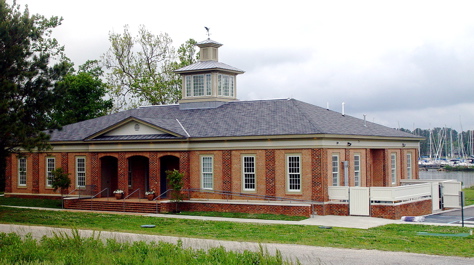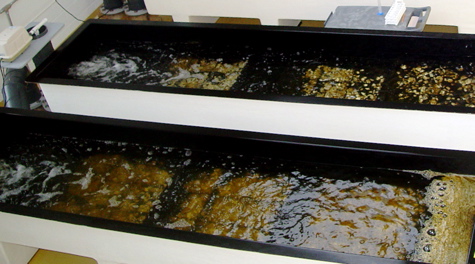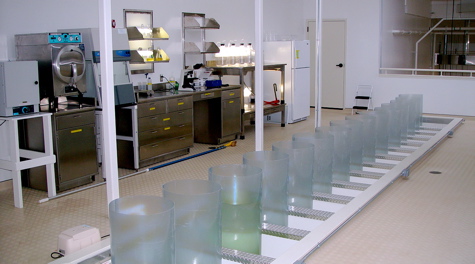Facilities & Equipment
The Kauffman facility contains three separate rooms that were each purpose-built to protect Chesapeake Bay and its living resources from disease, parasites, or the unintentional introduction of non-natives.
Oyster Isolation Laboratory
This room is designed to hold recently imported non-native species in quarantine from the rest of the facility and the external environment. Quarantine is maintained through use of a re-circulating seawater system whose effluent is subjected to temperatures high enough to kill any living contaminants. The room also operates at air pressures lower than its surroundings to prevent the unlikely release of any airborne pathogens. Leak detectors further minimize the possibility of any groundwater leakage. This room can be entered and exited only through a decontamination area.
An impermeable membrane beneath the Oyster Isolation lab prevents discharges to groundwater.
Health Certification & Reproductive Containment Laboratory
This room is designed to further minimize disease concerns and to prevent spawn from any experimental oysters from entering the Bay. Residence in this room is restricted to 2nd-generation oysters, a constraint that prevents the propagation of any disease or parasites that might be present in imported oysters. Effluent from this room's re-circulating seawater system is treated with ozone to kill any spawn it may contain.
Second-generation oysters in this lab are certified disease-free according to protocols set forth in the Aquatic Animal Health Code, a set of internationally agreed standards established by the Office International des Epizooties. OIE is the official arbiter of the World Trade Organization for living animal products, including wild or aquacultured marine animals.
Natives Laboratory
This "reverse quarantine" room is designed to keep native oysters from being exposed to MSX and Dermo, two diseases that have devastated wild oyster populations in Chesapeake Bay. Maintenance of disease-free specimens of the native oyster Crassostrea virginica is important in light of on-going breeding and restoration efforts for this species. Isolation is accomplished using a flow-through seawater system equipped with high-efficiency filters.
Operations & Analysis Laboratory
This lab is the "nerve center" for the entire facility. It holds equipment for monitoring water quality in the seawater systems and for assessing the condition of animals held in quarantine. Digital connections to sensors elsewhere in the facility allow the Center manager to monitor many systems remotely. Because almost all tanks in the Center are "closed" systems that use re-circulating seawater, it is important to monitor their metabolite levels, which indicate the health of the biological filters. This lab is designed for future addition of cryopreservation capabilities, which will allow for long-term storage of frozen sperm for breeding purposes.
The remainder of the building is devoted to equipment for algal culture (to produce the algae that are needed to feed oysters in a re-circulating seawater system), and mechanical systems. Public access to the working parts of the facility is limited due to biosecurity concerns.
Technical innovations developed at the Kauffman Center promise to create a robust future for environmentally responsible aquaculture. These innovations and the development of strategic oyster farming can help to reduce pressures on the wild resources in Chesapeake Bay and locations worldwide. In addition, restoration efforts can be accelerated with the use of oysters genetically modified to resist diseases currently prevalent in the Bay.





